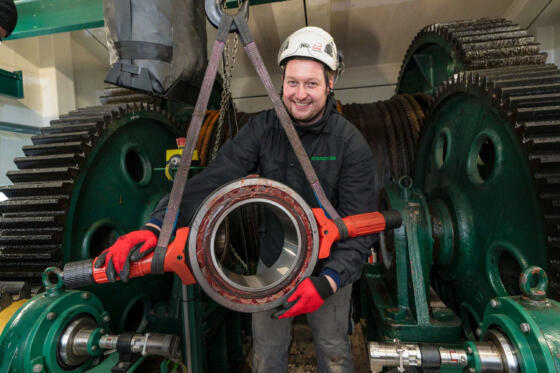
Joining forces for faster findings
On May 16, 1960, Theodore Maiman, a merely 32-year-old physicist at Hughes Research Laboratories in Malibu, California, broke new ground when he and his team fired the world’s first laser. The event marked a breakthrough at least from today’s perspective because the modern world of technology can hardly be imagined without laser systems. The ultraconcentrated light beam is used in manufacturing technology (for cutting, drilling, welding, etc.), medicine (for cancer radiation therapy, retinal surgery, etc.), analytics and measuring technology, in everyday applications such as scanner cash registers and laser printers as well as in the field of mobility such as lidar sensors for autonomous driving. However, 60 years ago, the first laser beam in technological history ended in nothing, or, as Irnee D’Haenens, one of Maiman’s assistants, jokingly said: “The laser is a solution looking for a problem,” or more precisely, for a way of putting the idea to good (industrial) use. The technology gained traction and the necessary boost for further development for other uses only in the nineteen-seventies when automotive and aircraft manufacturers recognized the value of laser systems for cutting and welding of metal. A happy ending of a late-blooming relationship between academia and business.
“In modern innovation management, research results without specific fields of application like in the case of the laser are sometimes referred to as a technology push. The opposite is referred to as a market pull, in other words a research project commissioned by industry enlisting the work of scientists to solve a specific problem. Technological evolution as we know it today would not be possible without these two variants of interdisciplinary collaboration,” explains Robert Klarner, who is responsible for technology transfer and business cooperation at the Oberpfaffenhofen location of the German Aerospace Center (DLR).
Increasing focus on practical relevance
Today, in Klarner’s view, it’s unlikely that almost a decade will pass until a key technology such as laser light achieves its breakthrough. “There’s a clear trend in technology push as well as in basic research toward proposing a project’s practical relevance, in other words its application in the marketplace, being proposed when the project is launched,” says the DLR expert. As a result, the basic work of scientific research can be transferred faster into market-ready products. Dr. Viola Gerlach from the Potsdam Institute for Advanced Sustainability Studies feels that this is of vital importance as well. In an article posted in her institute’s blog, she writes: “The societal relevance of scientific research processes and their results are more likely to be called into question in the future. They will be measured by their capacity to add real value to our quality of life and the sustainable development of our society.”
For DLR expert Klarner, it’s clear that, in addition to higher practical relevance of science, collaboration with the business community must be intensified both in the technology push and in the market pull realms. For one, because accelerated technology development coupled with increasing technological complexity requires that and for the other, because such collaborative partnerships should serve as a joint lever to achieve a successful transformation of business and society toward sustainability.
Transformation can only be achieved through collaboration
In view of the major current and future challenges, this is not only about concentrating technological expertise but – as the Fraunhofer Institute for Systems and Innovation Research ISI – notes in a position paper – also about minimizing financial risks by distributing the burden to several shoulders. Another fact that, according to Fraunhofer, makes a case for closer integration of science and business is that, in view of growing complexities, resources, both in terms of knowledge and capital, are often no longer in adequate supply for one party to handle the entire development process on its own.
Schaeffler’s Chief Technology Officer Uwe Wagner emphasizes such positions: “Global challenges and transformations in mobility, digitalization or energy supply can only be mastered in close collaboration between society, science and industry,” he says. Consequently, despite its high in-house development output – the company has been in the top 3 spots of the (German) patent registration ranking for years – Schaeffler has a long track record of working together successfully with scientific innovation hotbeds such as DLR, Helmholtz and Fraunhofer. The university-level collaboration project SHARE (Schaeffler Hubs for Advanced Research) launched in 2013 has evolved into a global research network with leading universities. In these research hubs, Schaeffler employees, doctoral students and students from the respective partnering universities work hand in hand. Research and corporate infrastructures are used synergistically. The research topics are mobility, hydrogen technologies and renewable energies as well as digitalization, robotics and Industry 4.0.

“There’s a trend toward greater practical relevance in scientific research.”
The benefits in such collaborative partnerships for companies like Schaeffler are obvious: Through access to scientific expertise and technologies time-to-market for innovations can be accelerated (or even enabled in the first place), resulting in competitive advantages. The academic institution in turn benefits from know-how, prestige and particularly from financial gains. “We grant licenses for technologies for which the licensees pay market prices. For research services that we’re commissioned to provide, we charge typical market prices as well,” explains DLR expert Klarner.
As a result, scientific operations can end up with considerable cash, depending on the market success of the innovation. Karlheinz Brandenburg, who is deemed to be the “father” of the mp3 format, estimates that this invention with all related further developments and licenses resulted in earnings of at least one half to one billion euros for his former employer, the Fraunhofer Institute. He benefited from some of the income as well. “I was able to build a dream house without a mortgage and start my own small venture capital firm,” he revealed in an interview with Redaktionsnetzwerk Deutschland.
No risk, no success
The development of disruptive innovations requires out-of-the-box thinking in research and development areas both in business and academia, according to DLR expert Klarner. That many disruptive innovations in the more recent past originated in the United States does not surprise him for several reasons. One of them is the fact that a culture that permits failure has evolved there also in the realm of research and science. While it’s true that a venture may fail, there’s equal truth in the saying “nothing ventured, nothing gained.” A pioneering spirit instead of a mindset excessively focused on security. “In the United States, the fear of missing out on a technological trend with corresponding market opportunities is more prevalent with businesses and investors alike than the fear of failure,” says Klarner. Accordingly, there’s a high willingness to take risks with new research subjects and entrepreneurship
The second reason is the high volume of corporate capital expenditures for research and development. According to the EU Industrial R&D Investment Scoreboard 2021, U.S. companies spending 344 billion euros per year invest more than their competitors in the EU (184 billion euros) and China (141 billion euros) combined. Klarner draws a comparison: “Money scores – in a metaphorical sense, what’s true in football is also true in the area of investment.”
Let’s keep talking about money or, more precisely, government grants for public teaching and research institutions. In many countries, they’re linked to the success of contract research. At the Fraunhofer Institute, this consistent market focus of research and development work was introduced as far back as 50 years ago, resulting in permanent and sustainable growth there. That’s why in Germany the interlinking of grants with the success of science-business partnerships is frequently referred to as the “Fraunhofer model.”
Spatial proximity promotes creativity
A creative environment is another important provider of impetus to fruitful science-business partnerships. “Clusters, in which teaching, research, science and business are engaged in close exchanges, are real innovation boosters,” says Klarner. Birds of a feather flock together. Around the globe, theme-focused clusters have formed in fields such as medicine, biotechnology, aerospace, mobility, finance, IT, wind and solar power, telecommunications, and sensor systems. Silicon Valley is the best-known example. Decisive impetus to the cluster formation there was provided 80 years ago by Frederick Terman, then a dean at Stanford University. In 1939, the professor of engineering supported two of his students in starting their electronics company. Their names: William Hewlett and David Packard. Today, HP is one of the biggest technology corporations in the world. Motivated by that success, Terman launched a program for promoting founders in pursuit of his aim to make the region attractive to new settlements and students starting their own businesses. He even provided them with capital, today referred to as venture capital and start-ups. More than 150 companies, including IBM and Apple, soon began to establish their headquarters at Stanford Industrial Park that was founded in 1951. That Stanford University was burgeoning concurrently with the rise of Silicon Valley underscores the interaction of such science-business partnerships. Today, the university is one of the most prestigious and research-intensive schools as well as the fourth-richest university in the world.




